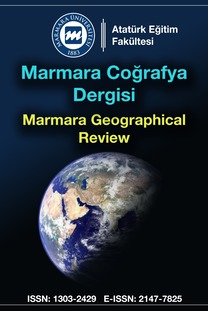Türkiye'de Ortaöğretim Coğrafya Derslerinde Teknoloji Kullanımı
Günümüzde yaşanan hızlı teknolojik gelişmeler hayatın tüm alanlarında olduğu gibi coğrafya öğretiminde de dünya genelinde büyük değişimlere sebeb olmaktadır. Aktif öğrenme ortamının oluşmasına sağladığı katkılardan ötürü, bilgisayar ve İnternet günümüzde coğrafya derslerinde en yaygın olarak kullanılan teknolojileri oluşturmaktadır. Bu teknolojiler pek çok ülkede coğrafya derslerinde yaygın olarak kullanılırken Türkiye’de bu konuda henüz önemli bir gelişme katedilememiştir. Bu çalışma, Türkiye’de coğrafya derslerinin işlendiği sınıflardaki teknolojilerin ne olduğu ve bunların ne sıklıkta kullanıldıkları konusunda bir fikir edinmek amacı ile yapılmıştır. Çalışmada 36 ayrı okulda görev yapan 46 coğrafya öğretmeni üzerinde bir anket çalışması uygulanmıştır. Çalışma sonucunda coğrafya dersleri işlenilen sınıfların teknolojik donanım açısından yeterli düzeyin altında oldukları görülmüştür. Ankete katılan öğretmenlerin coğrafya derslerini işledikleri sınıfların % 48’inde bilgisayar, % 35’inde LCD projektör ve % 26’sında ise İnternet bağlantısı vardır. Ancak öğretmenlerden sadece % 7’si bilgisayarı, % 2’si ise LCD projektörü her derste kullandığını belirtmiştir. İnterneti her derste kullanan öğretmen ise yoktur. Çalışmada ayrıca sınıflarda bilgisayar, LCD projektör ve İnternet bağlantısı olma durumu ve bunların coğrafya derslerinde kullanılma sıklıkları açısından özel okulların devlet okullarına göre daha iyi durumda oldukları görülmüştür.
___
Bartsch, R. A., & Cobern, K.M. (2003). Effective of PowerPoint presentations in lectures. Computers and Education, 41, 77-86.Bransford, J., Brown, A. & Cockıng, R. (2000). How people learn: brain, mind, experience and school. National Academic Press, Washington, DC.
Bıshop, M.P. (1992). Computer issues in geography: operating in an integrated environment. Collegiate Microcomputer, 10, 148-154.
Bıshop, M. P. (1995). Integration of computer technology and interactive learning in geographic education. Journal of Geography in Higher Education, 19(1), 97-110.
Chlopak, O. (2002). Computers in Russian schools: current conditions, main problems, and prospects for the future. Computers & Education, 40, 41-55.
Crampton, J.W. (1998). Integrating the web and the geography curriculum: The Bosian virtual fieldtrip. Journal of Geography 98, 155-168.
Demirci, A. (2005). ABD’de eğitim sistemi ve coğrafya öğretimi, Aktif Yayınevi, İstanbul.
Fıtzpatrıck, C. (1993). Teaching geography with computers, Journal of Geography, 94(2), 156-159.
Hattler, J. A. (1999). Technology for preservice teachers: “Driver education” for the information Superhighway. Jornal of Technology and Teacher Education, 7(4), 323-332.
Jonassen, D. H. (1999). Computers as mindtools for schools: Engaging critical thinking (second ed.). Englewood Cliffs, NJ: Prentice Hall.
Joshua, E. S. (2005). PowerPoint’s power in the classroom: enhancing student’s self-efficacy and attitudes. Computer & Education, 45, 203-215.
Keeler, C. M. (1996). Networked instructional computers in the elementary classroom and their effect on the learning environment: a qualitative evaluation. Journal of Research on Computing in Education, 28(3), 329–345.
Lemke, K. A., & Rıtter, M.E. (2000). JGHE symposium: Virtual geographies and the use of the İnternet for learning and teaching geography in higher education. Journal of Geography in Higher Education, 24(1), 87-91.
O’neıl, J. (1995). Teachers and technology: Potential and pitfalls. Educational Leadership, 53(2), 10-11.
Ramasundaram, V., Grunwald, S., Mongeot, A., Comerford, N. B., & Blıss, C. M. (2005). Development of an environmental virtual field laboratory. Computers & Education, 45, 21-34.
Rozalınd, G. & Muır, H. (2004). Technology and its impact in the classroom. Computers and Education, 42, 111-131.
Rutherford, D. & Lloyd, W. J. (2001). Assessing a computer-aided instructional strategy in a World Geography course. Journal of Geography in Higher Education, 25(3), 341-355.
Ruthven, K., Nennessy, S., & Deaney, R. (2005). Incorporating İnternet resources into classroom practice: pedagogical perspectives and stragegies of secondary-school subject teachers. Computer & Education, 44, 1-34.
Seal, K. C. & Przasnyskı, Z. H. (2001). Using the World Wide Web for teaching improvement. Computers and Education, 36, 33-40.
Smeets, E. (2005). Does ICT contribute to powerful learning environments in primary education? Computers and Education, 44, 343-355.
Wentz, E. A., Vender, J. C., & Brewer, C.A. (1999). An evaluation of teaching introductory geomorphology using computer-based tools. Journal of Geography in Higher Education, 23(2), 167-176.
Wınn, W. & Snyder, D. (1996). Cognitive perspectives in psychology. In: Jonassen, D. H., Editor, 1996. Handbook of research in educational communications and technology, Macmillan, New York, 112–142.
- ISSN: 1303-2429
- Yayın Aralığı: Yılda 2 Sayı
- Başlangıç: 1997
- Yayıncı: Marmara Üniversitesi
Sayıdaki Diğer Makaleler
Eşme (Uşak) Civarında Bazı Coğrafi Gözlemler
XVI. Yüzyılda Manisa Şehrinin Nüfus Özellikleri
Trabzon Havalimanı'na Coğrafi Bir Yaklaşım
Avrupa Birliği'ne Uyum Sürecinde Türkiye'deki Tarımsal İşletmelerin Günümüzdeki Durumu
Çanakkale Boğazı Petrol Kirlilik Düzeyinin Saptanması
Türkiye'de Ortaöğretim Coğrafya Derslerinde Teknoloji Kullanımı
ALİ DEMİRCİ, Halil İbrahim TAŞ, Ali ÖZEL
